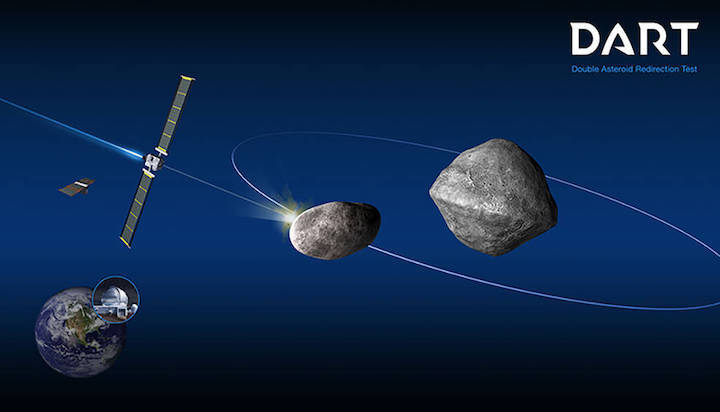6.09.2018
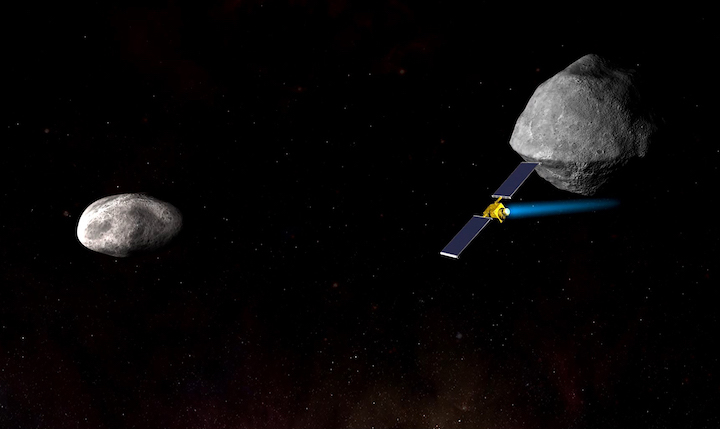
Artist’s impression of NASA’s Double Asteroid Redirection Test (DART) spacecraft speeding toward the smaller of the two bodies in the Didymos asteroid system.
-
The first-ever mission to demonstrate an asteroid deflection technique for planetary defense has moved into the final design and assembly phase, following NASA’s approval on Aug. 16.
The Double Asteroid Redirection Test (DART), being designed, built and managed by the Johns Hopkins Applied Physics Laboratory in Laurel, Maryland, will test what’s known as the kinetic impactor technique — striking an asteroid to shift its orbit — and take a critical step in demonstrating how to protect our planet from a potential impact.
DART’s target is the asteroid Didymos, a binary system that consists of Didymos A, about one-half mile in size, and a smaller asteroid orbiting it called Didymos B, about 530 feet across. After launch — scheduled for spring/summer 2021 — DART will fly to Didymos (Greek for “twin”) and use an APL-developed onboard targeting system to aim itself at Didymos B. Then the spacecraft, about the size of a small car, would strike the smaller body at approximately 3.7 miles per second.
“With DART, we want to understand the nature of asteroids by seeing how a representative body reacts when impacted, with an eye toward applying that knowledge if we are faced with the need to deflect an incoming object,” said APL’s Andrew Rivkin, who co-leads the DART investigation with APL’s Andrew Cheng. “In addition, DART will be the first planned visit to a binary asteroid system, which is an important subset of near-Earth asteroids and one we have yet to fully understand.”
The kinetic impact technique works by making a very small change in the orbital speed of the target asteroid. DART will demonstrate the kinetic impact technique and will measure the effect of the DART impact. Observatories on Earth will determine the resulting change in the orbit of Didymos B around Didymos A, allowing scientists around the world to better determine the capabilities of kinetic impact as an asteroid mitigation strategy.
To assess and formulate capabilities to address potential asteroid threats, NASA established its Planetary Defense Coordination Office in 2016, which is responsible for finding, tracking and characterizing potentially hazardous asteroids and comets coming near Earth, issuing warnings about possible impacts, and assisting plans for and coordination of a U.S. government response to an actual impact threat.
APL manages DART for NASA’s Planetary Missions Program Office at Marshall Space Flight Center in Huntsville, Alabama. DART also is supported by teams from Goddard Space Flight Center, Greenbelt, Maryland; Johnson Space Center, Houston; Glenn Research Center, Cleveland; Langley Research Center, Hampton, Virginia; the Jet Propulsion Laboratory, Pasadena, California; the University of Maryland, College Park; University of Colorado, Boulder; Lawrence Livermore National Laboratory, Livermore, California; and Aerojet Rocketdyne, Arlington, Virginia.
To learn more about NASA planetary defense and DART, visit: https://www.nasa.gov/planetarydefense and http://dart.jhuapl.edu/.
Quelle: The Johns Hopkins University
----
Update: 14.04.2019
.
DART Mission Set to Launch on SpaceX Falcon 9
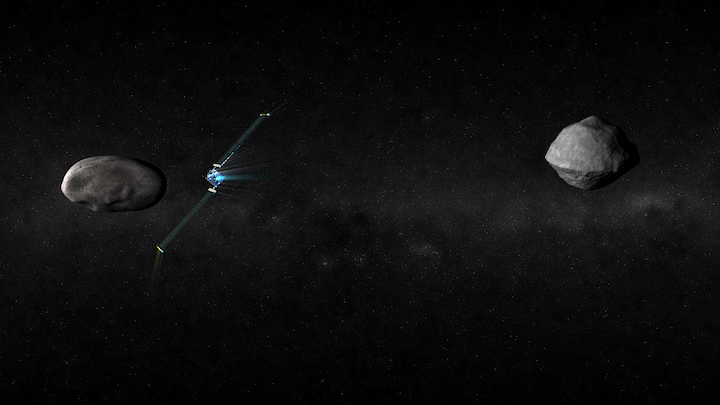
DART will target the smaller of the two objects (left) that make up the binary asteroid Didymos, which will be about 7 million miles (11 million kilometers) from Earth at the time of impact, scheduled for October 2022.
Credit: NASA/Johns Hopkins APL
NASA’s first planetary defense mission, the Double Asteroid Redirection Test (DART), has been slated for a June 2021 launch aboard a SpaceX Falcon 9 rocket from Vandenberg Air Force Base, California. The mission, led by the Johns Hopkins University Applied Physics Laboratory (APL) in Laurel, Maryland, will be the first to demonstrate the kinetic impactor technique, which involves slamming a spacecraft into an asteroid at high speed to shift it off course.
“We’re excited that NASA has selected the vehicle to launch DART on its important planetary defense mission,” said DART Mission Systems Engineer Elena Adams, of APL. “The DART team is eager to move ahead with our spacecraft and mission designs and demonstrate, for the first time in space, a method to keep potentially hazardous bodies from reaching Earth.”
DART will target the smaller of the two objects that make up the binary asteroid Didymos, which will be about 7 million miles (11 million kilometers) from Earth at the time of impact, scheduled for October 2022.
APL will build and operate the DART spacecraft and manages the mission for the Planetary Missions Program Office at Marshall Space Flight Center in Huntsville, Alabama. DART also is supported by teams from the Goddard Space Flight Center, Greenbelt, Maryland; Johnson Space Center, Houston, Texas; and the Jet Propulsion Laboratory, Pasadena, California.
Quelle: THE JOHNS HOPKINS UNIVERSITY
----
Update: 15.04.2019
.
SpaceX’s Falcon 9 wins launch of an asteroid-attacking NASA spacecraft
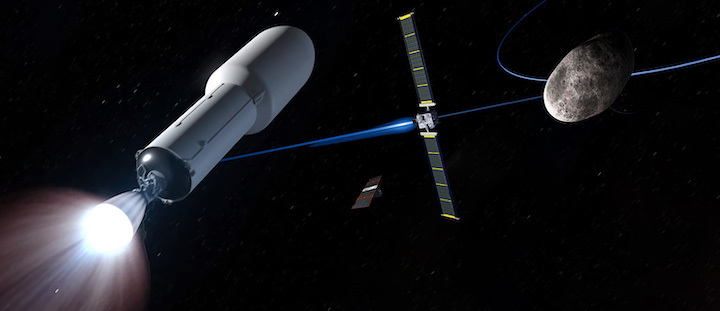
Just minutes before SpaceX began fueling Falcon Heavy for its commercial launch debut, NASA announced that the company had won a contract for its Double Asteroid Redirection Test (DART) mission, to be launched by Falcon 9 for the low cost of $69M.
Designed to cost less than $250M total, the DART mission will aim to be as light and fast as possible, using a dedicated Falcon 9 to send the ~600 kg (~1300 lb) spacecraft and its Italian companion cubesat on an ~11 million kilometer (~7M mi) journey to the binary asteroid Didymos. The ultimate purpose of DART is to effectively prove out both technologies and physics that could be used in the future to defend Earth from asteroids known to be on a collision course.
If all goes as planned during DART’s imminent design review milestones and hardware integration, Falcon 9 could launch the spacecraft towards the Didymos asteroid system in June 2021 for an October 2022 arrival. That “arrival” would involve DART impacting Didymos-B – the smaller of the pair at 163 m (535 ft) across – at a relative velocity of more than 6 km/s (3.7 mi/s). Nicknamed Didymoon, Didymos-B effectively orbits Didymos-A. At that speed, the ~600 kg probe will create an impact with the equivalent explosive force of nearly two and a half tons of TNT, the purpose of which is to determine just how much the sheer kinetic energy of impact can modify a small body’s orbit around the main asteroid.
Estimates from the spacecraft’s mission managers expect Didymoon’s orbit to be shifted by about 1% as measured by the time it takes to orbit Didymos-A, from ~11.9 hours to ~11.8 to 12.0 hours. This is a very small change but one that should – in theory – be easily measurable by telescopes on Earth, despite the fact that Didymoon has been estimated to have a mass of approximately 3.5 million metric tons (7.6 billion pounds), approximately seven million times heavier than DART. In short, NASA is going to functionally bomb an asteroid moon to see if humans might be able to use kinetic impactors to gently ‘boop’ threatening space objects off of the offending trajectory years or even decades in advance.
Despite the inherently destructive, single-use nature that DART’s impactor status bestows, current plans thankfully include an Italian cubesat known as LICIACube. The small copassenger will deploy two days before impact to fully exploit the scientific value of DART’s demise with high-quality photos of the event and aftermath. LICIACube will be traveling the same speed and thus won’t be able to enter orbit around the asteroid system, but a European Space Agency (ESA) mission known as Hera plans to do just that in the mid-2020s to better characterize Didymos and the crater (hopefully) made by DART.
Aside from the mission itself, DART serves as a technology demonstration platform for NASA. It will mark the first in-space use of the NASA-built NEXT-C ion thruster and powerpack, as well as the first standalone use of Roll-Out Solar Array (ROSA) deployment mechanism (shown above being tested on the ISS). Even more intriguing is a proposed transformational solar array planned at one point for DART, a flexible combination of advanced solar cells (~33% efficient) and mirror concentrators that could feed a spacecraft five times as much power for a given solar array area and distance from the sun. It’s unclear whether this will make it into DART’s final design but it still appears to be on the table as of January 2019. According to the contracted manufacturer, DART’s solar array will produce ~6.6 kW, while rough estimates suggest that the solar array will have an area of 16 m^2 (170 ft^2). Relative to the simplicity of the deployment mechanism and small size of DART (~600 kg total), this is an incredible amount of accessible power.
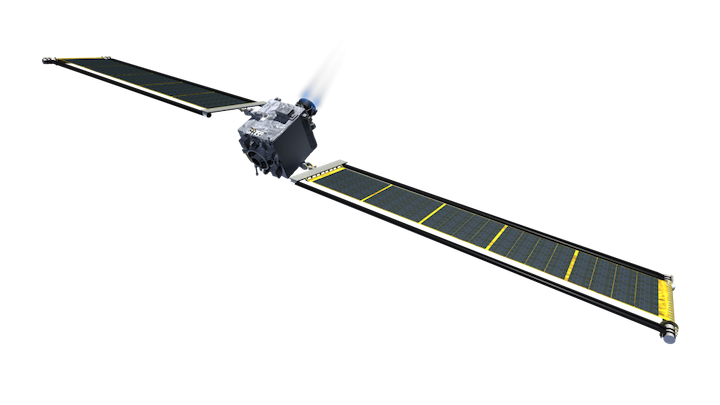
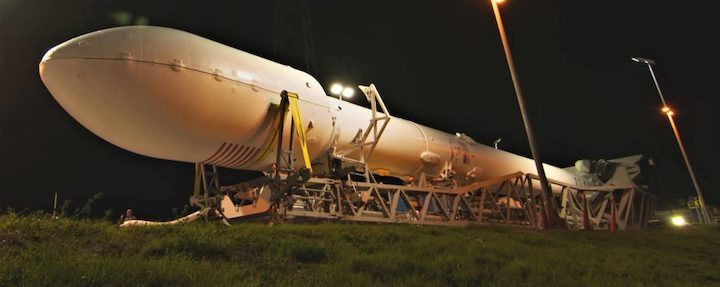
GETTING TO ORBIT
For NASA’s SpaceX launch contract, the agency will pay just $69M, barely 10% above Falcon 9’s bare-minimum list price of $62M. It’s safe to assume that the timing of the contract award – days after SpaceX abruptly dropped an official protest of ULA winning a ~$150M NASA contract – might not be coincidence. Regardless, SpaceX’s decision to bid so low for a NASA launch does lend some serious credence to the company’s protest that ULA’s contract for the mission – NASA’s LUCY asteroid explorer – was “vastly more [expensive]” than the bid SpaceX submitted.
Weighing just ~600 kg (~1300 lb) wet, DART could end up launching with additional copassengers on Falcon 9, although there is a precedent set by NASA’s ~360 kg TESS and Taiwan’s Formosat-5 for SpaceX giving tiny spacecraft dedicated launches. Additionally, it’s possible that DART will launch on a flight-proven Falcon 9 Block 5 rocket, given the likelihood that NASA will have certified flight-proven SpaceX vehicles for almost any launch by 2021.
Quelle: TESLARATI
----
Update: 12.05.2019
.


